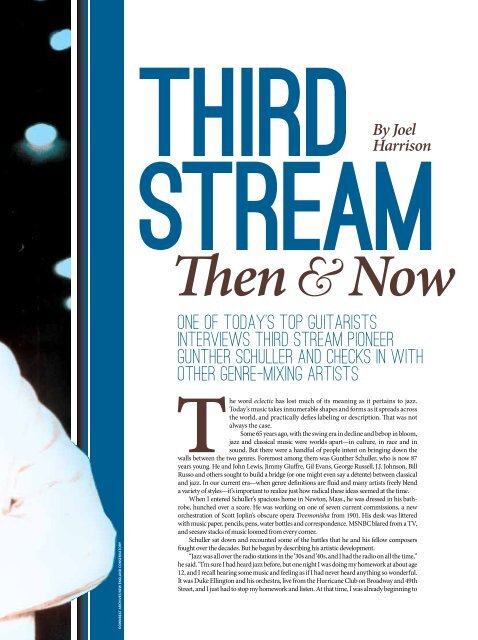Create successful ePaper yourself
Turn your PDF publications into a flip-book with our unique Google optimized e-Paper software.
Third<br />
Stream<br />
Then<br />
By Joel<br />
Harrison<br />
Now<br />
One of today’s top guitarists<br />
interviews Third Stream pioneer<br />
Gunther Schuller and checks in with<br />
other genre-mixing artists<br />
DownBeat Archives/New England Conservatory<br />
The word eclectic has lost much of its meaning as it pertains to jazz.<br />
Today’s music takes innumerable shapes and forms as it spreads across<br />
the world, and practically defies labeling or description. That was not<br />
always the case.<br />
Some 65 years ago, with the swing era in decline and bebop in bloom,<br />
jazz and classical music were worlds apart—in culture, in race and in<br />
sound. But there were a handful of people intent on bringing down the<br />
walls between the two genres. Foremost among them was Gunther Schuller, who is now 87<br />
years young. He and John Lewis, Jimmy Giuffre, Gil Evans, George Russell, J.J. Johnson, Bill<br />
Russo and others sought to build a bridge (or one might even say a détente) between classical<br />
and jazz. In our current era—when genre definitions are fluid and many artists freely blend<br />
a variety of styles—it’s important to realize just how radical these ideas seemed at the time.<br />
When I entered Schuller’s spacious home in Newton, Mass., he was dressed in his bathrobe,<br />
hunched over a score. He was working on one of seven current commissions, a new<br />
orchestration of Scott Joplin’s obscure opera Treemonisha from 1901. His desk was littered<br />
with music paper, pencils, pens, water bottles and correspondence. MSNBC blared from a TV,<br />
and seesaw stacks of music loomed from every corner.<br />
Schuller sat down and recounted some of the battles that he and his fellow composers<br />
fought over the decades. But he began by describing his artistic development.<br />
“Jazz was all over the radio stations in the ’30s and ’40s, and I had the radio on all the time,”<br />
he said. “I’m sure I had heard jazz before, but one night I was doing my homework at about age<br />
12, and I recall hearing some music and feeling as if I had never heard anything so wonderful.<br />
It was Duke Ellington and his orchestra, live from the Hurricane Club on Broadway and 49th<br />
Street, and I just had to stop my homework and listen. At that time, I was already beginning to

















